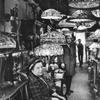Retrospective of Ralph Steadman, British Graphic Artist and Hunter S. Thompson’s Gonzo Journalism Collaborator, in D.C. this Summer
- WASHINGTON, DC
- /
- February 16, 2018

“Buy the ticket, take the ride.” – Hunter S. Thompson
Celebrating the career of one of Britain’s most important graphic artists of the last 50 years, the American University Museum at the Katzen Arts Center in Washington, D.C., will feature “Ralph Steadman: A Retrospective,” a collection of more than 100 original art works that will take viewers on a journey through the artist’s wide-ranging career, from sketches created in the 1950s, to book illustrations, to present-day work. The show at American University Museum is currently the only museum exhibition on the East Coast and the first museum stop in a limited United States tour. “Ralph Steadman: A Retrospective” will be open June 16 and run through Aug. 12, 2018.

Steadman is famous for his long collaboration with the writer Hunter S. Thompson, most notably providing the illustrations for Fear and Loathing in Las Vegas (1971), and helping to create what has since become known as ‘Gonzo’ journalism. Steadman has attained a cult status and has influenced many graphic and comic artists. His art has won him an international reputation for which he’s received numerous awards. His own illustrated books have been translated into several languages and his work has been exhibited around the world.
The exhibition explores the full range of the artist’s work, including his earliest published cartoon from 1956, material from Private Eye, Punch, the Observer, the New Statesman and Rolling Stone, and illustrations he provided for literary classics such as George Orwell’s Animal Farm. There are atmospheric wine drawings produced for Oddbins catalogues, humanitarian pictures, savage political cartoons and some of his charming and funny illustrations for children’s books. The show also includes examples of the extinct birds and imaginary ‘boids’ which he created for Extinct Boids, art work inspired by the television-cable series Breaking Bad and images from Steadman’s most recent book, Critical Critters. The exhibition is accompanied by a 160-page, full-color catalogue that includes forewords by actor Johnny Depp, journalist and critic Carlo McCormick and artist Anita Kunz.

“Ralph Steadman: A Retrospective” first went on display in The Cartoon Museum in central London and was curated by Anita O’Brien and Chris Miles. Ralph Steadman Art Collection acknowledges and thanks exhibition sponsors and partners Audible; Jim Caruso, CEO, Flying Dog; and United Therapeutics.
The American University Museum at the Katzen Arts Center is open from 11 a.m. to 4 p.m. Tuesday through Sunday. Admission is free. For more information, call 202-885-1300 or look on the Web at www.american.edu/cas/museum.
Ralph Steadman was born in Wallasey, Liverpool on 15 May 1936. His first published cartoon appeared in the Manchester Evening Chronicle in July 1956. From the early 1960s his work began appearing in magazines such as Punch and Private Eye and became a key part of what became known as ‘The Satire Boom’. Later in the 1960s he also began to create illustrated books for both children and adults. His award-winning 1967 version of Lewis Carroll’s classic Alice in Wonderland was followed five years later by his even more striking Through the Looking-Glass.
In the spring of 1970 Steadman visited America and collaborated for the first time with the writer Hunter S. Thompson. The following year he produced the drawings to accompany Thompson’s definitive Rolling Stone piece, Fear and Loathing in Las Vegas: A Savage Journey to the Heart of the American Dream. Steadman hadn’t actually been on the chemically assisted trip, but the drawings have always been seen as the perfect visual expression of Thompson’s wild, gonzotic prose. During the 1970s he and Thompson would cover other major American political events such as the presidential campaign of 1972 and the Watergate hearings.
In the 1970s Steadman drew for a wide range of publications including The Times, The New York Times, the New Statesman, Observer Magazine and the Radio Times. He also began work on the first of a series of innovative books. Sigmund Freud (1979) was followed by I, Leonardo (1983) and The Big I Am (1988), in which he took the voice of God Himself and addressed the big question: ‘Why he/she/it was such a vindictive old bastard and what the hell it could have to do with me’. Steadman has been the subject of a number of TV documentaries made by the BBC and Channel 4.
During the late 1980s and 1990s he travelled the world on behalf of Oddbins Wine Merchants, visiting vineyards and whisky distilleries, sampling their wares and meeting their makers. The result was a series of witty and beautiful images which filled Oddbins wine and whisky catalogues.
In the 2000s he formed a new partnership with the writer Will Self, illustrating his ‘Psychogeography’ column in the Independent. Following the death of Hunter S. Thompson in 2005 he helped organise the writer’s dramatic send-off in Colorado. In The Joke’s Over. Bruised Memories: Gonzo, Hunter Thompson and Me (2006) he recounted their close but at times fractious relationship, as well as touching on his own wider career.
In 2011 he was approached by the filmmaker Ceri Levy to produce a drawing of an extinct bird for a conservationist show, Ghosts of Gone Birds. One picture became a hundred pictures of birds, extinct and imaginary, published as a book, Extinct Boids in 2012, co-written with Ceri Levy. 2012 also saw the release of the film documentary about Steadman, For No Good Reason. Filmmaker Charlie Paul filmed Steadman at work for over a decade and in conversation with his good friend Johnny Depp.













100x100_c.jpg)


